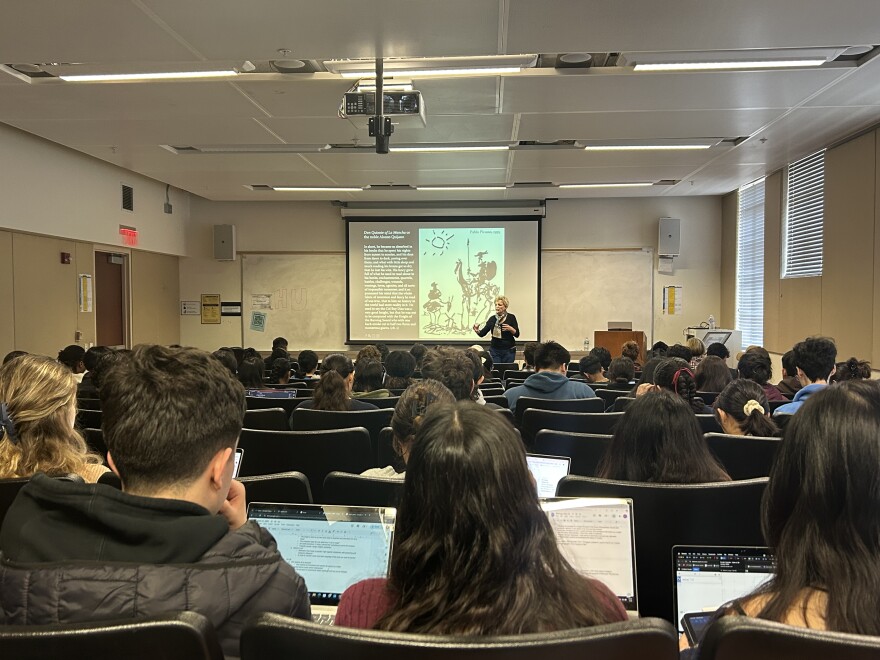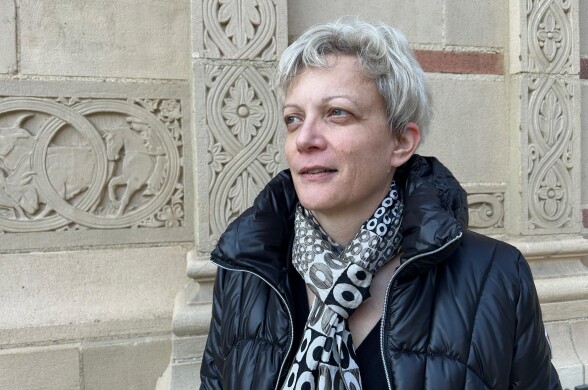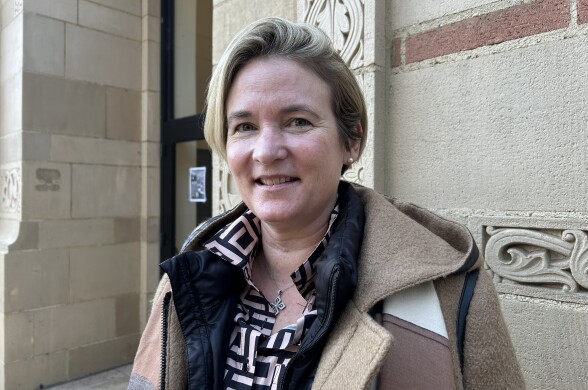Truth matters. Community matters. Your support makes both possible. LAist is one of the few places where news remains independent and free from political and corporate influence. Stand up for truth and for LAist. Make your year-end tax-deductible gift now.
Instead of banning AI, this UCLA literature class embraces it

At first glance, Zrinka Stahuljak’s comparative literature class appears to be like any other in the humanities — a hundred UCLA undergraduates in a lecture hall talking about "The Ingenious Gentleman Don Quixote of La Mancha."
Yet it’s actually the first in the division to use a digital textbook created using artificial intelligence. The homework assignments? Also created using AI. And same for the discussion guides.
While some colleges have moved to ban AI over fears of plagiarism or inaccuracy, UCLA has embraced it. Through a platform called Kudu, developed in-house, professors use AI to help students access course material and save money. The platform also lets professors customize their textbooks and lesson plans and provides 24-hour support.
Supporters say it’s also a tool for relieving long-standing issues related to higher ed and technology.
What can AI do for educators?
Almost immediately after her students took their seats during a recent class, Stahuljak asked them to take out their phones, scan a QR code, and answer a brief questionnaire.
“Based on their feedback, we'll know what they need a little bit more support on. And then, we will update the textbook to reflect that,” said Elizabeth Landers, a doctoral candidate in history who helped create the course materials and continues to customize them for students.
Stahuljak has taught Comp Lit 2BW since 2017. To create the textbook and its accompanying AI features for this semester, she provided Landers with notes from previous iterations of the class, along with the PowerPoint presentations and YouTube videos she created for remote instruction during the COVID-19 pandemic.
All of that became the database for the textbook, Landers said. “Then, we made a very detailed outline and began the content generation process.” Stahuljak and another history major carefully reviewed the end result.
“It's not just about facts,” Stahuljak said. “It is about the tone. It is about the style. It is about the narrative. What is the journey we're taking our students on?”
“There’s a misconception that AI did everything,” Landers added. In reality, she and her colleagues put in “hundreds and hundreds of hours into this course.”
“Everything has been guided by humans, checked by humans, imagined by humans,” she said.
How did AI come to a humanities class?
Outside of the humanities, other professors have also modified their Kudu textbooks to fit the needs of a particular class.
Physics professor Alexander Kusenko co-developed the platform with a former graduate student. When he arrived at UCLA, he was appalled to find that textbooks could cost his students a couple hundred dollars. Today, Kudu is available for $25 per course.
When Kusenko’s colleague Andrea Ghez was awarded a Nobel Prize for her discovery of a supermassive black hole in the galactic center, he added a section in his textbook about the discovery. Then he added a homework problem that discussed the motion of one of the stars close to the supermassive black hole.
The ability to include recent developments and highlight the work of his colleagues, Kusenko said, “makes teaching more fun for me and more interesting for the students.”
Professors at UCLA also value that Kudu is a closed-loop system: In other words, when students ask the platform about course material, it only provides answers from resources that professors have approved.
As a complement to Kudu, students also have Kai, a Siri-like virtual assistant available to them 24/7.
“That is another great advantage,” Kusenko said, “because when I teach a class of 200 people, I cannot spend enough time with every student individually. And this is unfortunate.”
Having Kai take care of facts and dates enables Stahuljak and her teaching assistants to focus on more enduring lessons with students, including: “how to construct a series of paragraphs that will support your argument” and “how to make a thesis rather than a description.”
“If you ask Kudu for restaurant recommendations, it will ask you to stay on topic,” said Warren Essey, Kudu’s co-developer. The system also “knows not to just answer the homework, but rather guide the students through homework problems.”
How do students actually use it?
Ella Chau, a first year psychobiology major, appreciates an AI feature that turns sections of the Comp Lit 2BW textbook into podcasts.
“It's really helpful,” she told LAist. Instead of having to sit down to read, she can learn key concepts as she makes her way through campus.
Some of the students in Stahuljak’s class are a little more wary of using AI, including first-year theater major Catherine Day.
Outside of the classroom, she’s occasionally used AI for collages or design projects.
“I don't really like AI writing tools,” she said. “I find that they kind of hamper my personal style of writing.”
Day said she appreciates the way the textbook is organized because she can check for comprehension by answering questions at the bottom — but she rarely uses the virtual assistant or podcast feature.
“I prefer to kind of just read it, draw my own conclusions, and use class as the time to reflect on what I have read and hear our professor's thoughts on it,” she said.
Warren Riley, a third-year English major, said he was also initially reluctant to use AI.
“I'm a proud writer, and I'm like, ‘I don't want anyone else to help me, especially a robot,’” he said.
Since then, he’s come to find that AI can be useful.
“Even as an English major, I don't always know how to properly use a semicolon,” he admitted. When that happens, Riley asks ChatGPT: "Did I use a semicolon correctly?"
“And I can just have another perspective on that,” he said.
In Comp Lit 2BW, Riley interacts similarly with Kai, the textbook’s virtual assistant.
“You don't always have immediate access to your professor, and not even your TA,” he said. They “have their own lives, and you can't ask them a bunch of silly questions about the text.”
When Riley doesn’t quite get how a text illustrates something about history, he asks Kai to weigh in. He likes that he can get an answer quickly, “at any time of the day.”
How can AI help struggling students?
Virtual assistants can be especially helpful for students who are struggling, Kusenko said.
Recently, he teamed up with some colleagues at UCLA’s Center for Education Innovation & Learning in the Sciences and at UC San Diego to set up a study that looks at the effects of AI virtual assistant tools and other interventions on learning outcomes.
“I was teaching two classes at the same time, and we were able to compare the outcomes because we turned the AI hints on and off in different chapters, in alternating fashion,” he said.
According to Kusenko, the paper shows that students who needed the most help (based on their initial performance on a physics test given during the first week of class) benefited the most when they used AI hints and supplemental materials.
Essey, Kusenko’s former graduate student, co-founded Kudu after working as a software engineer at Google. He stressed the importance of making sure that all students have access to “the same high-quality AI.”
By way of example, he pointed to the material difference between ChatGPT 4 (the newest model) and ChatGPT 3 (an older model). The latter is free to use. In contrast, ChatGPT 4 has a limited free version, but a more-expansive version costs at least $20 a month to access.
Newer models are trained on more recent data, Essey explained, so the quality of answers differ. AI tools that are available for free also tend to have usage limitations, such as how many questions you can ask.
“We're always using that latest model for the students,” he added, “so they get at least the equivalent to the premium models.”
“People were worried AI would go the other way around, that it would replace educators,” Essey said. “And we've taken the bet that it will actually empower them.”













